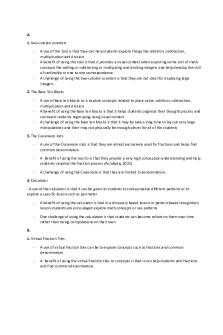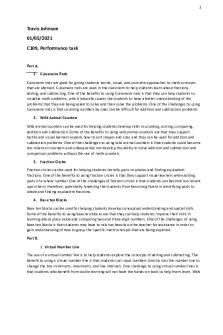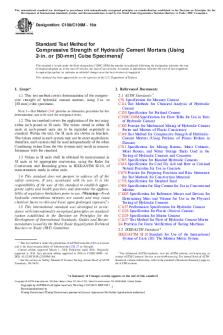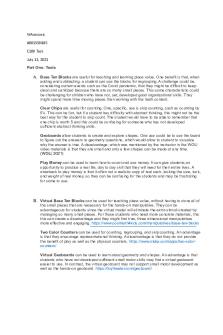C109 Math Methods Task 1 PDF

| Title | C109 Math Methods Task 1 |
|---|---|
| Author | Lori Patel |
| Course | Educational Technology for Teaching and Learning |
| Institution | Western Governors University |
| Pages | 6 |
| File Size | 158.6 KB |
| File Type | |
| Total Downloads | 38 |
| Total Views | 172 |
Summary
Task 1...
Description
WGU C109 Math Methods Task A – Hands on Manipulatives 1. Magnetic Differentiated Base Ten Blocks a. Classroom use- Magnetic base ten blocks can be used to develop a deeper understanding of place value concepts. b. Advantage- They keep the pieces together better without them being thrown all over the table or floor. c. Disadvantage- Multiple sets of magnetic base ten blocks would need to be purchased for use during small groups. 2. Plastic Cuisenaire Rods a. Classroom use- Plastic Cuisenaire rods can be used to explore whole numbers, fractions, measurement, ratio, etc. b. Advantage- They are easy to clean and store. c. Disadvantage- They are very costly and would be difficult to have more than one set. 3. Rekenrek 20-Bead Wood Individual Student Frame a. Classroom use- Rekenrek frame can be used to help students identify numbers without counting using the color-coded beads. b. Advantage- It has 2 hooks and can be hung up for easy visualization by all students. c. Disadvantage- They only contain 20 beads making it difficult to study larger numbers. 4. Place Value Disks a. Classroom use- Place value disks can be used to learn counting, grouping, addition, and subtraction. b. Advantage- They are labeled with place values from ones to millions. c. Disadvantage- They contain a lot of little pieces that could potentially get lost. B – Virtual Manipulatives 1. Virtual Cuisenaire Rods
a. Classroom use- Virtual Cuisenaire rods can be used to introduce addition, subtraction, geometry, measurement, multiplication, and division. b. Advantage- They eliminate the need for proper storage and cleaning. c. Disadvantage- The entire class would need a Chromebook or a visit to the computer lab. 2. Virtual Geoboard a. Classroom use – to create line segments and polygons. b. Advantage- accessible to students using devices they are familiar using already and can be done independently. Can also be attributed to real world applications. c. Disadvantage- the devices that a virtual geoboard would need to ne used on are costly and may not be available to every student in the class to have one at the same time. 3. Virtual Base Ten Blocks a. Classroom use- Used to teach place value in the classroom and allows students to “explain” their work. b. Advantage- Virtual Base Ten Blocks allows students to create many different sets of base tens, to practice addition, subtraction, value and other math skills. c. Disadvantage- the controls may not always work well. There is a limit of characters in the equation entry. Also, the visual style isn’t greatly engaging. 4. Fake/Play Money a. Classroom use- to learn to count money, value of the coins and dollar bills and to count change. b. Advantage- real money isn’t being used. No loss of coins on the floor, no missing money and is “clean”. c. Disadvantage- Kinesthetic learners may find this way not very helpful, if they are not able to actually hold and touch the money.
GENERAL INFORMATION Lesson Title & Subject(s): Bundle of One’s and Ten’s
Topic or Unit of Study: Place Value Grade/Level: 1 Instructional Setting: 26 students total (15 boys and 11 girls)
o o o
19 students are on-grade-level readers 5 students are two grades above reading level (2 with identified gifted exceptionalities) 2 students are English language learners at the intermediate level
o
Seating arrangement: The classroom is set up with 4 desks grouped together, computer/art on one side and a Smartboard in the front.
STANDARDS AND OBJECTIVES Your State Core Curriculum/Student Achievement Standard(s): CCSS.MATH.CONTENT.1.NBT.B.2.A 10 can be thought of as a bundle of ten ones — called a "ten." Lesson Objective(s): When given a quiz, students will be able to color the correct number of bubbles under each ones and tens column from the written number given, with 80% proficiency. MATERIALS AND RESOURCES Instructional Materials:
Place value disks Colored pencils/crayons Magnetic base ten blocks
Resources: List any sources used during the planning of the lesson using the APA format. INSTRUCTIONAL PLAN Sequence of Instructional Procedures/Activities/Events (provide description and indicate approximate time for each): 1. Student Prerequisite Skills/Connections to Previous Learning: Each student previously learned how to use base ten blocks for the place values of ones. 2. Presentation Procedures for New Information and/or Modeling:
Presentation Procedures for New Information: The purpose of this lesson is for the students to correctly color the number of bubbles based on the written number given in the correct ones and tens column. I will display a single digit number on the Smartboard for the entire class to see. Each group will work together and create the number using their set of magnetic base ten blocks. Modeling: I will now show the students how to incorporate the base ten blocks with a double digit number (ones and tens). I will display an example of this on the Smartboard using virtual base ten blocks. 3. Guided Practice: Each group will be given a ring of notecards. Each notecard will contain a double digit number. They are to use their magnetic base ten blocks to represent each given number. As they work in their groups, I will circulate from group to group, providing assistance while also asking questions to see if they know how to change the base ten blocks according to a change in place value. 4. Independent Student Practice: Students will remain in their groups and choose their own double digit number. They will now create a poster displaying their chosen number in color coded circles of their choice. One color will represent the ones place while a second color will represent the tens place. I will circulate throughout the room to monitor their work. Their poster will then be displayed out in the hallway. After creating their poster they will be given a worksheet to complete as a group called Base Ten Riddles. These riddles will make them use problem solving and critical thinking skills to figure out the correct number. The worksheet will read for example, “I have 6 tens and 4 ones. What number am I?” 5. Culminating or Closing Procedure/Activity/Event: Following their poster activity they will sit down to take their quiz. There will be a total of 10 questions. For each question there will be a double digit written number. Beside each number there will be columns of bubbles. They are to color each column with a different color representing the correct bubbles in the ones and tens column. During the quiz I will circulate the class monitoring for completion of own work. Instructional Strategy (or Strategies):
Interactive instruction was used when the students learned from their teacher and peer groups helping to develop social skills and abilities while also organizing their thoughts. Hands on learning was used during guided practice as the students worked in their peer groups using the magnetic base ten blocks. Collaborative learning was used when they were working together in their peer groups. This lesson also contains all of the steps in direct instruction.
Differentiated Instruction Accommodations:
Gifted Accommodation- during guided practice as I circulate from group to group, I will ask the gifted students questions about the hundreds place and see if they can correctly represent a three digit number with their magnetic base ten blocks. ELL Accommodation- these students will be guided during presentation both orally and in writing. This way they can feel confident in the expectations of the lesson.
Use of Technology: A Smartboard is used to model information from the teacher by displaying virtual base ten blocks. Student Assessment/Rubrics: The teacher will know the objective has been met if when given a quiz, students will be able to color the correct number of bubbles under each ones and tens column from the written number given, with 80% proficiency.
D. Instructional Materials During the guided practice the students used magnetic base ten blocks to represent each double digit number given in the ring of notecards. Magnetic base ten blocks are a really good hands on manipulative to help with visualization of numbers. They also help the students physically represent a number while developing a deeper understanding of the concept. By having them start with prior knowledge of single digit numbers, they were able to practice using the blocks correctly. This helped the transition of new information make sense and also made independent practice run smoother, allowing less teacher guidance. E. Instructional Plan
Critical Thinking- During the guided practice when students were working collaboratively in small groups they critically thought when they were asked questions by the teacher according to their group work. This required critical thinking because these questions could not be answered with a simple yes or no. They had to involve their prior knowledge along with the new content they had just learned. If the group contained any of the gifted students, the questions were slightly more complicated making them think even deeper. Problem Solving- During the independent student practice when students were engaged in peer group work, the students used problem solving when they were given a worksheet for base ten riddles. This required problem solving because they were to complete the worksheet as a group. They had to use context clues in the riddle questions to figure out the correct number and place value. Context clues help them to make meaning in solving the problems.
Performance Skills- During the independent student practice, the students used performance skills when they were communicating with their peer groups. This
required performance skills because they had to use place value discourse to complete the activities expected. With four students creating one poster they have to communicate using the discourse for it to all come together correctly. In the end the poster will reflect how well they listened to the lesson along with how well they can communicate. F. Instructional Strategy During the guided practice and independent student practice, I used collaborative learning when the students had to solve a problem, complete a task, and create a product as a peer group. This lesson was full of active engagement where every student worked together toward a common goal. Collaboration was an effective instructional strategy because keeping the students active, social, and engaged will lead to deeper thinking. This type of strategy will also develop a higher level of thinking, better oral communication, self-management, and leadership skills....
Similar Free PDFs

C109 Math Methods Task 1
- 6 Pages

C109 Task 1 - C109 Task 1
- 5 Pages

Math Methods Task
- 8 Pages

C109 Task 1 wgu.edu
- 8 Pages

C109 performance task
- 10 Pages

Mathmatic Methods task 1
- 17 Pages

Math Tool Options - Task 1
- 9 Pages

ASTM C109 - ASTM C109
- 10 Pages

Task 1 Math Tools lesson plan
- 13 Pages

2017 Math Methods exam 2
- 25 Pages
Popular Institutions
- Tinajero National High School - Annex
- Politeknik Caltex Riau
- Yokohama City University
- SGT University
- University of Al-Qadisiyah
- Divine Word College of Vigan
- Techniek College Rotterdam
- Universidade de Santiago
- Universiti Teknologi MARA Cawangan Johor Kampus Pasir Gudang
- Poltekkes Kemenkes Yogyakarta
- Baguio City National High School
- Colegio san marcos
- preparatoria uno
- Centro de Bachillerato Tecnológico Industrial y de Servicios No. 107
- Dalian Maritime University
- Quang Trung Secondary School
- Colegio Tecnológico en Informática
- Corporación Regional de Educación Superior
- Grupo CEDVA
- Dar Al Uloom University
- Centro de Estudios Preuniversitarios de la Universidad Nacional de Ingeniería
- 上智大学
- Aakash International School, Nuna Majara
- San Felipe Neri Catholic School
- Kang Chiao International School - New Taipei City
- Misamis Occidental National High School
- Institución Educativa Escuela Normal Juan Ladrilleros
- Kolehiyo ng Pantukan
- Batanes State College
- Instituto Continental
- Sekolah Menengah Kejuruan Kesehatan Kaltara (Tarakan)
- Colegio de La Inmaculada Concepcion - Cebu





